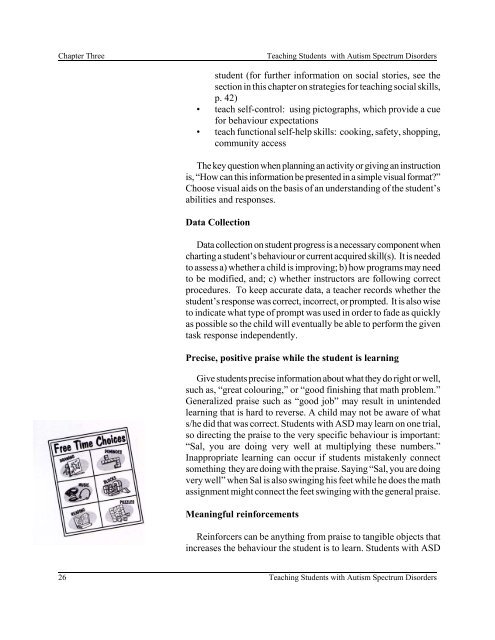Teaching Students with Autism Spectrum Disorders
Teaching Students with Autism Spectrum Disorders
Teaching Students with Autism Spectrum Disorders
You also want an ePaper? Increase the reach of your titles
YUMPU automatically turns print PDFs into web optimized ePapers that Google loves.
Chapter Three <strong>Teaching</strong> <strong>Students</strong> <strong>with</strong> <strong>Autism</strong> <strong>Spectrum</strong> <strong>Disorders</strong><br />
student (for further information on social stories, see the<br />
section in this chapter on strategies for teaching social skills,<br />
p. 42)<br />
• teach self-control: using pictographs, which provide a cue<br />
for behaviour expectations<br />
• teach functional self-help skills: cooking, safety, shopping,<br />
community access<br />
The key question when planning an activity or giving an instruction<br />
is, “How can this information be presented in a simple visual format?”<br />
Choose visual aids on the basis of an understanding of the student’s<br />
abilities and responses.<br />
Data Collection<br />
Data collection on student progress is a necessary component when<br />
charting a student’s behaviour or current acquired skill(s). It is needed<br />
to assess a) whether a child is improving; b) how programs may need<br />
to be modified, and; c) whether instructors are following correct<br />
procedures. To keep accurate data, a teacher records whether the<br />
student’s response was correct, incorrect, or prompted. It is also wise<br />
to indicate what type of prompt was used in order to fade as quickly<br />
as possible so the child will eventually be able to perform the given<br />
task response independently.<br />
Precise, positive praise while the student is learning<br />
Give students precise information about what they do right or well,<br />
such as, “great colouring,” or “good finishing that math problem.”<br />
Generalized praise such as “good job” may result in unintended<br />
learning that is hard to reverse. A child may not be aware of what<br />
s/he did that was correct. <strong>Students</strong> <strong>with</strong> ASD may learn on one trial,<br />
so directing the praise to the very specific behaviour is important:<br />
“Sal, you are doing very well at multiplying these numbers.”<br />
Inappropriate learning can occur if students mistakenly connect<br />
something they are doing <strong>with</strong> the praise. Saying “Sal, you are doing<br />
very well” when Sal is also swinging his feet while he does the math<br />
assignment might connect the feet swinging <strong>with</strong> the general praise.<br />
Meaningful reinforcements<br />
Reinforcers can be anything from praise to tangible objects that<br />
increases the behaviour the student is to learn. <strong>Students</strong> <strong>with</strong> ASD<br />
26 <strong>Teaching</strong> <strong>Students</strong> <strong>with</strong> <strong>Autism</strong> <strong>Spectrum</strong> <strong>Disorders</strong>

















